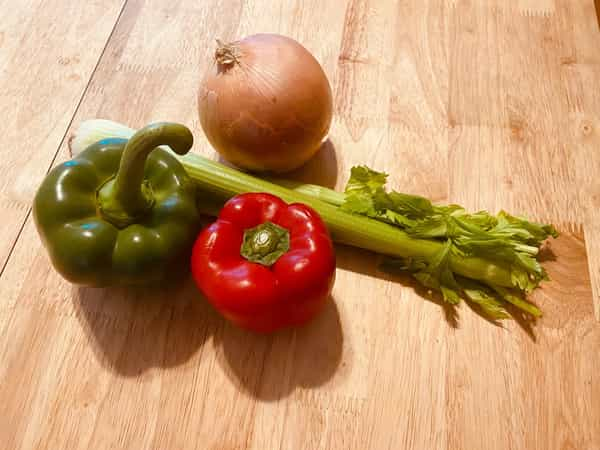When the cool air of Autumn arrives in Chicago, my wife often longs for her hometown of New Orleans. She misses the lively parades, the soulful jazz music, and most of all, the comforting food that the city is known for. To ease her homesickness, I make it a point to whip up a hearty pot of gumbo. It's my way of bringing a taste of New Orleans to our Midwest home. Join me as we delve into the world of gumbo, a dish that not only warms the belly but also fills our hearts with memories of the vibrant city she holds dear.

The Components
The Meats
Cajun gumbo is renowned for its diverse blend of meats, each contributing its own unique flavor to the dish. In traditional Cajun fashion, gumbo enthusiasts have experimented with a wide range of proteins, from the rich and smoky Andouille sausage to succulent shrimp straight from the Gulf waters. You might even come across versions featuring rabbit, squirrel, or ham, showcasing the Cajun penchant for resourcefulness and flavor complexity.
Traditionally, a chef will use whatever he/she/they may have on hand. And today I will be doing just that. My arsenal includes chicken thighs, ham steaks, shrimp, and andouille sausage.
The Holy Trinity
In the world of Cajun cuisine, the Holy Trinity reigns supreme, replacing the traditional French mirepoix with a trio of ingredients that forms the flavor backbone of countless dishes, including our beloved gumbo. Comprised of chopped onions, bell peppers, and celery, the Cajun Holy Trinity imparts a depth of flavor and aromatic richness that is as distinctive as it is essential. While the French mirepoix brings sweetness to their culinary creations, the Holy Trinity injects a burst of earthy, spicy notes, reflecting the bold and zesty spirit of Cajun cooking. As we embark on our gumbo-making adventure, keep an eye out for this dynamic trio, for it is the key to unlocking the soul of this revered Louisiana dish.
A few smashed cloves of garlic bring the trio home, of course.

In the world of Cajun cooking, the "red roux" stands as a culinary cornerstone, setting itself apart from the more familiar white or blonde roux found in many dishes. This unique roux is created by patiently cooking a mixture of flour and fat until it transforms into a rich, dark brick color. It's a labor of love that requires a watchful eye and a little bit of Cajun magic.
Why go to all this trouble? The answer lies in the incomparable depth and complexity it adds to the dish. Beyond its thickening properties, the red roux imparts a toasty, nutty flavor that is the very essence of Cajun cuisine. It's that elusive "spice" you can't quite pinpoint but can't imagine the dish without. Whether in a gumbo, étouffée, or tomato gravy, this dark roux is the secret ingredient that elevates the flavors and leaves an indelible mark on every Cajun creation.
Chef’s Note: The longer we toast our roux, the less thickening power it has. Therefore, we will be making a larger batch of roux than we would for other recipes involving this thickening agent.
The Spices
In the art of gumbo-making, the use of dry spices like thyme, oregano, and bay leaves is a time-honored tradition that brings depth and complexity to the dish. Contrary to what one might think, the drying process of these spices isn't a compromise… it's an enhancement. As these herbs and leaves dry, their flavors concentrate, and their polyphenols become more pronounced. This intensifies the aromatic essence they infuse into the gumbo, contributing to its distinctive and robust flavor profile. If you have fresh herbs on hand, use them! But don’t fear the dry, jarred spices that so many chefs turn their noses up at!
When it comes to choosing the cooking liquid for gumbo, there's room for flexibility. Some chefs opt for water, relying on the richness of the ingredients to infuse flavor, while others, like myself, lean towards chicken stock for an extra layer of savory depth. In a stew like gumbo, improvisation often leads to delightful results, so feel free to use whatever you have on hand or your preferred liquid of choice to craft a gumbo that suits your taste buds perfectly.
Gumbo
Scroll down for a printable version of this recipe
Yields: 8 servings
Prep time: 25 minutes
Cooking time: approx. 90 minutes
1 stick of unsalted butter
4 Tablespoons Grapeseed oil
1 cup all-purpose flour
1 large onion
1 red bell pepper
1 green bell pepper
3 ribs celery
5 cloves garlic
4 skinless chicken thighs, diced
1 pound Andouille sausage, sliced
1/2 pound medium shrimp, tails off
1/2 pound ham, diced
3 Tablespoons dry thyme
1 Tablespoons dry oregano
4 bay leaves
4 cups chicken stock
1 lemon, juiced
Chopped parsley for garnish
Steamed white rice for serving
In a large stockpot, begin by combining butter and grapeseed oil (or your preferred cooking oil) over medium heat until the butter is fully melted. Once the mixture is smooth, add the flour, ensuring it's thoroughly combined. Now, the key is to maintain low-medium-low heat and stir occasionally. Over the next 30-45 minutes, the roux will gradually thin and transform into a deep brick-red hue.
While the roux works its magic, it's time to prepare the vegetables. Dice the onion, peppers, and celery into medium-sized pieces, and give the garlic cloves a good smash. Set these vibrant veggies aside. Additionally, dice and slice your chosen meats, ready to be introduced to the pot later.
Now, it's time to add your preferred meats and generously cover them with stock. Stir in the dry spices and cover the pot. Let the mixture simmer for about 45-60 minutes until the meats reach that coveted tenderness.
Finally, remove the pot from the heat and squeeze the juice of one lemon into the mixture. To serve, ladle the flavorful gumbo over a bed of white rice and garnish with fresh parsley. Enjoy!
If you want to learn how to make an authentic menu from a chef from New Orleans, don't miss our Hands-On Trip to the Bayou with Chef Brian Jupiter on Friday, October 20 at 6pm. Born and raised in New Orleans, Chef Jupiter pulls inspiration from closely held family secrets and recipes learned by spending time with his great-grandmother in the kitchen. Have fun savoring Southern cuisine as Chef Jupiter brings a taste of the Bayou to The Chopping Block for an exciting hands-on cooking class celebrating his roots. There are just five spots left, so sign up now!
Gumbo
Ingredients
- 1 stick of unsalted butter
- 4 Tablespoons grapeseed oil
- 1 cup all-purpose flour
- 1 large onion
- 1 red bell pepper
- 1 green bell pepper
- 3 ribs celery
- 5 cloves garlic
- 4 skinless chicken thighs, diced
- 1 pound Andouille sausage, sliced
- 1/2 pound medium shrimp, tails off
- 1/2 pound ham, diced
- 3 Tablespoons dry thyme
- 1 Tablespoons dry oregano
- 4 bay leaves
- 4 cups chicken stock
- 1 lemon, juiced
- Chopped parsley for garnish
- Steamed white rice for serving
Instructions
- In a large stockpot, combine butter and grapeseed oil over medium heat until the butter is fully melted. Once the mixture is smooth, add the flour, ensuring it's thoroughly combined. Maintain low-medium-low heat and stir occasionally. Over the next 30-45 minutes, the roux will gradually thin and transform into a deep brick-red hue.
- Dice the onion, peppers, and celery into medium-sized pieces, and give the garlic cloves a good smash. Set these veggies aside. Dice and slice your chosen proteins and set aside.
- Once the roux has achieved that appealing red-brown hue, add the prepared vegetables into the mix. Add a tablespoon of kosher salt and stir, ensuring the vegetables are well-coated with the roux. Continue to cook until the onions turn lightly translucent.
- Add your preferred protein and generously cover them with stock. Stir in the dry spices and cover the pot. Let the mixture simmer for about 45-60 minutes until the protein reach that coveted tenderness.
- Once the meats are tender to your liking, give the gumbo a taste and adjust the seasoning with salt if needed.
- Remove the pot from the heat and squeeze the juice of one lemon into the mixture. To serve, ladle the flavorful gumbo over a bed of white rice and garnish with fresh parsley.
